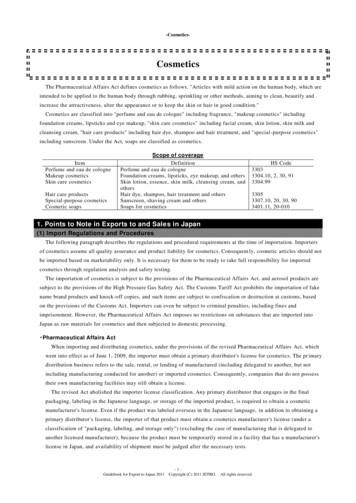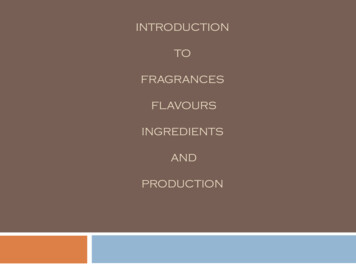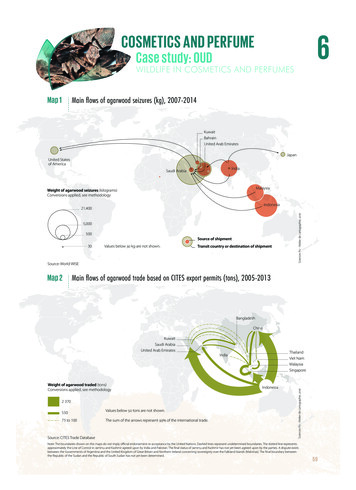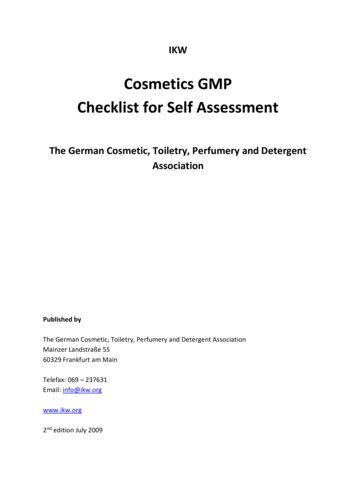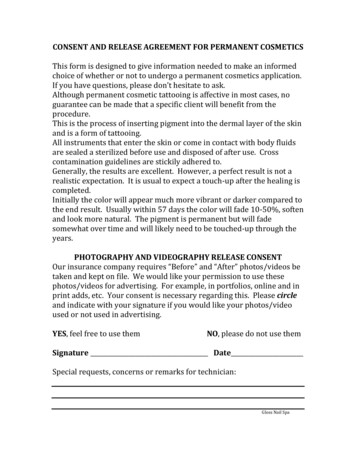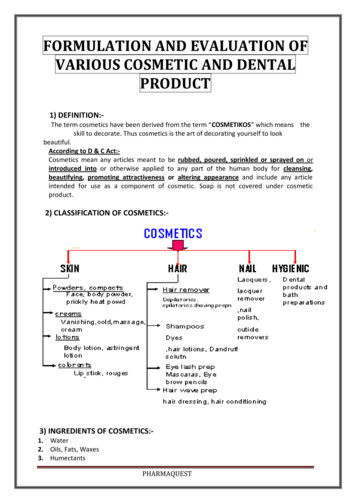
Transcription
United StatesEnvironmental ProtectionAgencyEnforcement andCompliance Assurance(2224A)EPA-305-S-97-003December 1997Perfumes, Cosmetics, and OtherToilet Preparations Manufacturing(SIC 2844)Statutory and Regulatory SummariesEPA Office of ComplianceChemical Industry BranchPrinted on paper that contains at least20 percent postconsumer fiber.
Background: The perfumes, cosmetics, and other toilet preparations manufacturingindustry is subject to numerous Federal regulations that have been enacted to protecthuman health and the environment. A complex web of requirements results from thefact that little correlation exists among regulations that target the same medium oractivity. Industrial facilities are responsible for understanding and complying with theserequirements. Historically, EPA has relied on a command and control approach toregulate industrial facilities, but now is combining its traditional method with innovativecompliance assessment techniques such as self-assessments and facility managementsystems.Many industrial facilities have found that using a complete facility EnvironmentalManagement System (EMS) approach uncovers cost effective solutions for tackling allthe requirements as a whole instead of as individual components. In line with thisdiscovery, EPA is encouraging self-assessments using a complete facility EMSapproach to evaluate compliance with environmental regulations. A facility’s drive toidentify cheaper, more effective ways to achieve compliance is consistent with EPA’smission of clarifying and simplifying environmental regulatory control.Purpose of document: This guide is a resource on Federal environmental regulationsfor perfumes, cosmetics, and other toilet preparations manufacturing facilities. Thismanual identifies and clarifies industry-specific regulatory information necessary toconduct a self-assessment. This document describes portions of environmentalstatutes that may apply to the perfumes, cosmetics, and other toilet preparationsmanufacturing industry and summarizes regulatory requirements of each (includingapplicability, exemptions, monitoring, record keeping, and reporting requirements).Approach: The statutes are discussed in the following sections:CClean Air Act (CAA): Clean Air Act Titles I, III, V, and VI are summarized in thissection. Topics include NAAQS, NESHAPs, MACTs, permitting, chemicalaccident protection, and stratospheric ozone protection. This appendix alsoincludes a section on assessment considerations that should be evaluatedduring the on-site facility assessment. Regulatory summaries are provided forperformance standards, national emission standards, provisions for preventionof chemical accidents, and protection of stratospheric ozone.CSafe Drinking Water Act (SDWA): This section describes the public watersystem program, underground injection control program, considerations forassessors, and regulatory requirements. Detailed descriptions of the regulatoryrequirements include national primary and secondary drinking water regulationswhich may be applicable to facilities that produce their own potable water andthe underground injection control program.
CResource Conservation and Recovery Act (RCRA):This section delineatesthe requirements for generation, transportation, treatment, storage, and disposalof hazardous waste. Land disposal restrictions and underground storage tankregulations are discussed, as are specific RCRA assessment considerations.RCRA legislation summarized for perfumes, cosmetics, and other toiletpreparations manufacturers includes classification of generators; requirementsfor hazardous waste generators and transporters; regulations for hazardouswaste treatment, storage, and disposal; and restrictions on land disposal andunderground storage tanks.CEmergency Planning and Community Right-to-Know Act (EPCRA):TheEPCRA section describes four regulatory programs applicable to perfumes,cosmetics, and other toilet preparations manufacturers: hazardous substancenotification, emergency planning and notification, hazardous chemical reportingto the community, and toxic chemical release inventory. The section alsosuggests key areas to evaluate during compliance assessments. Regulatorysummaries are included for the following: designation, notification, andreportable quantities of hazardous substances; emergency planning andnotification; and reporting of hazardous chemicals and toxic chemical releases.CClean Water Act (CWA):This section includes effluent limit guidelines,categorical pretreatment standards, NPDES and pretreatment programs, effluenttrading, spills and pollution prevention of oil and hazardous substances, andreportable quantities of hazardous substances. This chapter also includes asection on assessment considerations and summaries of regulations pertainingto pretreatment and discharge of effluent, discharge and pollution prevention ofoil, and designation of hazardous substances and reportable quantities.This manual may not include all the Federal environmental regulations that anperfumes, cosmetics, and other toilet preparations manufacturer must comply with, butit should serve as a starting point. Site assessors should be aware that, in manyinstances, State or local regulations may be more stringent than Federal requirements.Also, site-specific Federal, State, or local permits may contain additional requirementsbeyond those specified in the regulations. As such, part of a facility’s EMS should beto check Federal, State and local regulations regularly and keep abreast of pendinglegislation that may impact the facility.Disclaimer: This document is intended as an aid to compliance with federal regulatoryrequirements. The document does not substitute for EPA’s regulations, nor is it a reg ulation. Thus, it cannot impose legally binding requirements on EPA, States, or theregulated community. Because circumstances vary, this document may not apply to aparticular situation, and facilities may be subject to requirements that are different fromor in addition to those described in this document. EPA may change this guidance.
NOTE TO USERS OF THIS DOCUMENTThis document contains internal hyperlinks. Internal links, notedwith magenta text, link the reader to the applicablesection, figure, etc. being referenced. In addition, selectingthe bookmark option from the top menu in the Adobe AcrobatReader provides the user with a point and click table of contentsto the first page of each statute to simplify navigation in thedocument.
TABLE OF CONTENTSClean Air Act Regulatory RequirementsNational Primary and Secondary Ambient Air Quality Standards . . . . . . . . . . . . . . . . . CAA-2National Emissions Standards for Hazardous Air Pollutants (NESHAP) and MaximumAchievable Control Technology (MACT) Standards . . . . . . . . . . . . . . . . . . . . . . . . . . CAA-6Permitting Program . . . . . . . . . . . . . . . . . . . . . . . . . . . . . . . . . . . . . . . . . . . . . . . . . . CAA-7Stratospheric Ozone Protection . . . . . . . . . . . . . . . . . . . . . . . . . . . . . . . . . . . . . . . . . CAA-8CAA Assessment Considerations . . . . . . . . . . . . . . . . . . . . . . . . . . . . . . . . . . . . . . . . CAA-9CAA Regulatory Requirements . . . . . . . . . . . . . . . . . . . . . . . . . . . . . . . . . . . . . . . . . CAA-12Safe Drinking Water Act Regulatory RequirementsPublic Water System Program . . . . . . . . . . . . . . . . . . . . . . . . . . . . . . . . . . . . . . . . . SDWA-1Underground Injection Control Program . . . . . . . . . . . . . . . . . . . . . . . . . . . . . . . . . SDWA-2SDWA Assessment Considerations. . . . . . . . . . . . . . . . . . . . . . . . . . . . . . . . . . . . . . SDWA-3SDWA Regulatory Requirements . . . . . . . . . . . . . . . . . . . . . . . . . . . . . . . . . . . . . . . SDWA-4Resource Conservation and Recovery Act RegulatoryRequirementsHazardous Waste Generation . . . . . . . . . . . . . . . . . . . . . . . . . . . . . . . . . . . . . . . . . RCRA-2Hazardous Waste Transportation Regulations . . . . . . . . . . . . . . . . . . . . . . . . . . . . . . RCRA-7Hazardous Waste Treatment, Storage, and Disposal Regulations . . . . . . . . . . . . . . . RCRA-7Land Disposal Restrictions . . . . . . . . . . . . . . . . . . . . . . . . . . . . . . . . . . . . . . . . . . . . RCRA-8Underground Storage Tank Regulations . . . . . . . . . . . . . . . . . . . . . . . . . . . . . . . . . . RCRA-9RCRA Assessment Considerations . . . . . . . . . . . . . . . . . . . . . . . . . . . . . . . . . . . . . RCRA-11RCRA Regulatory Requirements . . . . . . . . . . . . . . . . . . . . . . . . . . . . . . . . . . . . . . . RCRA-12Emergency Planning and Community Right-to-Know Act Regulatory RequirementsHazardous Substance Notification . . . . . . . . . . . . . . . . . . . . . . . . . . . . . . . . . . . . .Emergency Planning and Notification . . . . . . . . . . . . . . . . . . . . . . . . . . . . . . . . . . .Hazardous Chemical Reporting: Community Right-to-Know . . . . . . . . . . . . . . . . .Toxic Chemical Release Inventory . . . . . . . . . . . . . . . . . . . . . . . . . . . . . . . . . . . . .EPCRA Assessment Considerations . . . . . . . . . . . . . . . . . . . . . . . . . . . . . . . . . . . .EPCRA Regulatory Requirements . . . . . . . . . . . . . . . . . . . . . . . . . . . . . . . . . . . . . .iiEPCRA-1EPCRA-1EPCRA-2EPCRA-2EPCRA-3EPCRA-4
Clean Water Act Regulatory RequirementsEffluent Limitations Guidelines and Categorical Pretreatment Standards . . . . . . . . . . . CWA-2NPDES Program . . . . . . . . . . . . . . . . . . . . . . . . . . . . . . . . . . . . . . . . . . . . . . . . . . . . CWA-3Pretreatment Program . . . . . . . . . . . . . . . . . . . . . . . . . . . . . . . . . . . . . . . . . . . . . . . . CWA-7Policy on Effluent Trading in Watersheds . . . . . . . . . . . . . . . . . . . . . . . . . . . . . . . . . . CWA-9Spills of Oil and Hazardous Substances . . . . . . . . . . . . . . . . . . . . . . . . . . . . . . . . . . . . CWA-9Oil Pollution Prevention . . . . . . . . . . . . . . . . . . . . . . . . . . . . . . . . . . . . . . . . . . . . . . CWA-10Reportable Quantities for Hazardous Substances . . . . . . . . . . . . . . . . . . . . . . . . . . . CWA-10CWA Assessment Considerations. . . . . . . . . . . . . . . . . . . . . . . . . . . . . . . . . . . . . . . CWA-10CWA Regulatory Requirements . . . . . . . . . . . . . . . . . . . . . . . . . . . . . . . . . . . . . . . . CWA-12iii
Clean Air Act (CAA)The Clean Air Act (CAA), with its 1990 amendments, sets the framework for air pollutioncontrol as it affects the perfumes, cosmetics, and other toilet preparations manufacturingindustry. This framework has several elements based upon individual titles in the CAA. Theapplicable CAA titles and the regulations and guidelines developed pursuant to the CAA areillustrated in Exhibit CAA-1 and are discussed below.Exhibit CAA-1. CAA Statutes and Regulatory Requirements for Perfumes, Cosmetics, andOther Toilet Preparations FacilitiesClean Air ActTitle ITitle IIITitle VTitle VIAttainment and Maintenance of National Air Ambient Quality StandardsAir ToxicsPermitting of Title I and III SourcesStratospheric Ozone SourcesTitle 1Title III40 CFR Part 50 NAAQS40 CFR Part 61 NESHAP40 CFR Part 60 New SourcePerformance Standards40 CFR Part 63 NESHAPNew Source Review (NSR)Reasonable Available ControlTechnology (RACT)GuidelinesTitle VTitle VI40 CFR Part 70or40 CFR Part 7140 CFR Part 82Maximum AchievableControl Technology(MACT) StandardsSeveral portions of Title I of the CAAaddress requirements for the attainmentand maintenance of National Ambient AirQuality Standards (NAAQS). The centralcomponents of the regulatory scheme ofthe Act may be said to include thefollowing:Clean Air ActNational Primary and Secondary Ambient AirQuality Standards . . . . . . . . . . . . . . . . . . . . . . CAA-2National Emissions Standards for HazardousAir Pollutants (NESHAP) and MaximumAchievable Control Technology (MACT)Standards . . . . . . . . . . . . . . . . . . . . . . . . . . . . CAA-6Permitting Program . . . . . . . . . . . . . . . . . . . . CAA-7Stratospheric Ozone Protection . . . . . . . . . . . CAA-8CAA Assessment Considerations . . . . . . . . . . CAA-9CAA Regulatory Requirements . . . . . . . . . . . CAA-12Perfumes, Cosmetics, and Other Toilet Preparations ManufacturingCAA-1
Section 107 pertaining to Air Quality Control RegionsSection 109 pertaining to National Ambient Air Quality StandardsSection 110 pertaining to State Implementation PlansSection 111 pertaining to New Source Performance StandardsSection 112 pertaining to National Emission Standards for Hazardous AirPollutants.Title V Permits will apply to major sources covered under Title I, as well as sources coveredunder other Titles of the Act.Title VI of the CAA deals with ozone-depleting chemicals. Several solvents used in theperfumes, cosmetics, and other toilet preparations manufacturing industry are affected by thislaw. Regulations under Title VI which affect the perfumes, cosmetics, and other toiletpreparations manufacturing industry are discussed in a section of this appendix.Finally, the specific regulatory requirements developed pursuant to the CAA are described inthe last section of this appendix.National Primary and Secondary Ambient Air Quality StandardsTitle I of the CAA establishes the statutory authority for EPA's National Ambient Air QualityStandards (NAAQS) that are to be applied uniformly throughout regions in the United States.The Air Quality Act of 1967 required the designation of air quality control regions (AQCRs) basedon "jurisdictional boundaries, urban-industrial concentrations, and other factors including atmosphericareas necessary to provide adequate implementation of air quality standards” [Section 107(a) (1967)].Today, the United States is divided into 247 AQCRs. Many AQCRs are subdivided intosmaller areas based on municipal boundaries, latitudes and longitudes, and other boundaries. Acomplete list of AQCRs (and their attainment status) is codified at 40 CFR Part 81. An airquality control region is classified as a "nonattainment" area if an NAAQS is violated anywhere inthe region. (In the case of ozone, a violation occurs if the 4th highest reading over any 24-hourperiod in the past 3 years exceeds the NAAQS for ozone.) Two types of NAAQS are set:(1)Primary standards that define the level of air quality necessary to prevent anyadverse impact on human health(2)Secondary standards that define the level of air quality necessary to protect thepublic welfare from any known or anticipated adverse effects of a pollutant.These standards, promulgated in 40 CFR Part 50, recognize that the severity of the adversehealth effects associated with exposure often depends on the duration of exposure.Accordingly, "short-term" standards set limits for a 1-hour, an 8-hour, or a 24-hour period,while "long-term" standards are established on an annual basis.Perfumes, Cosmetics, and Other Toilet Preparations ManufacturingCAA-2
The EPA has set NAAQS for ozone, carbon monoxide, particulate matter of 10 microns or less(PM-10), sulfur dioxide (SOx), nitrogen dioxide (NOx), and lead. These standards are used as afoundation for the regulatory framework discussed in this section. The NAAQS are not likelyto have a significant impact on the perfumes, cosmetics, and other toilet preparationsmanufacturing industry.Existing Sources of EmissionsOzone Non-attainment Areas - The "design value" shown in the third column of Exhibit CAA-2 iscompared to the 4th highest reading taken over any 24-hour period during 3 concurrent yearsin a nonattainment area. Based on this value, a nonattainment area is classified as Marginal,Moderate, Serious, Severe, or Extreme. As shown in Exhibit CAA-1, attainment deadlines arebased on a sliding scale that reflects the severity of the pollution, where the trigger date is thedate when an area is designated as nonattainment.Exhibit CAA-2. Classification of Ozone Nonattainment AreasDeadlines to Attain(from November 15, 1990)Design Value (ppm)Marginal3 Years0.121 - 0.138Moderate6 Years0.138 - 0.160Serious9 Years0.160 - 0.180Severe15 Years17 Years0.180 - 0.1900.190 - 0.280Extreme20 YearsAbove 0.280ClassificationA major source is defined both by the size of the source's facility-widefacility-wide emissions and thecategory of the nonattainment area. These conditions are presented in Exhibit CAA-3. Inaddition, if a firm has the potential to emit more than 100 tons per year (TPY), it is alsoconsidered to be a major source. The statement "potential to emit" means the maximumcapacity of a stationary source to emit a pollutant under its physical and operational design.Thus operating below capacity does not exclude a plant from being defined as a major source.Any physical or operational limitations on the capacity of the source to emit a pollutant,provided the limitation or its effect on emissions is federally-enforceable, are treated as part ofits design and therefore, could mean exclusion from the major category.Each State is required to develop a State Implementation Plan (SIP) for all nonattainment areas.SIPs contain a range of requirements that are designed to decrease ambient ozoneconcentrations. Part D of Title I of the CAA provides the authority for implementation ofReasonably Available Control Technology (RACT). A source defined as "major" in anonattainment area must install the RACT as prescribed in the applicable SIP.Perfumes, Cosmetics, and Other Toilet Preparations ManufacturingCAA-3
Exhibit CAA-3. Major Source ClassificationsCategory of Nonattainment AreaSize of VOC or NOX Sources Affected derate and Marginal100EPA has defined RACT as the lowest emission limitation that a particular source is capable ofmeeting by the application of control technology that is reasonably available consideringtechnological and economic feasibility. RACT for a particular source is determined on acase-by-case basis, considering the technological and economic circumstances of the individualsource. Further guidance for RACT is provided in the General Preamble published on April16, 1992, in 57 FR 13498-13570.EPA regulations provide that less stringent emission limitations than those achievable withRACT are acceptable only if the State plan shows that the less stringent limitations are sufficientto attain and maintain NAAQS, and show reasonable further progress during the interim beforeattainment.A single ozone transport region exists for eleven states and the District of Columbia (thenortheast ozone transport region). States included in the ozone transport region must submitSIPs to the EPA with special requirements pertaining to enhanced vehicle inspection andmaintenance programs and implementation of RACT with respect to all sources of volatileorganic compounds in the States. In addition, a stationary source in the ozone transportNOX is consideredregion that emits or has the potential to emit at least 50 TPY of VOCs for NOa major source and is subject to the requirements which would be applicable to majorstationary sources if the area were classified as a Moderate nonattainment area.A determination of the applicable RACT requirements for major sources is usually made by aState on the basis of a case-by-case review of each facility. In an attempt to issue uniformsource guidelines, EPA issues Control Techniques Guidelines (CTGs) for industrial categories.The specific CTGs for a source are available through EPA's Technology Transfer Network.There are several CTGs that may be relevant to perfumes, cosmetics, and other toiletpreparations manufacturing plants regarding the control of Volatile Organic Compounds(VOCs) from petroleum and volatile organic liquid storage and wastewater operations.New Source ReviewPersons constructing new major stationary sources of air pollution or making modifications tomajor stationary sources are required by the Clean Air Act to obtain a permit beforecommencing construction. The process is called new source review (NSR) and is requiredPerfumes, Cosmetics, and Other Toilet Preparations ManufacturingCAA-4
whether the major source or modification is planned for an area where the NAAQS areexceeded (nonattainment areas) or an area where air quality is acceptable (attainment andprevention ofunclassifiable areas). Permits for sources in attainment areas are referred to aspreventionsignificant air quality deteriorationdeterioration (PSD) requirements and include the following: Installation of Best AvailableControl Technology (BACT) A detailed air quality analysisshowing that there will be noviolation of PSD "increments" Prediction of future air qualitystandards Possible monitoring of airquality for 1 year prior to theissuance of the permit Demonstration of standard attainment through the undertaking of an air qualityanalysis.EPA determines BACT requirements by:(1) identifying all control technologies; (2)eliminating technically infeasible options;(3) ranking remaining control options bycontrol effectiveness; (4) evaluating themost effective controls and documentingresults; and (5) selecting BACT. SeeDraft New Source Review WorkshopManual, U.S. EPA, Office of Air QualityPlanning and Standards, October 1990.Restrictions in nonattainment areas are more severe. The principal requirements of NSR innonattainment areas are: Installation of Lowest Achievable Emission Rate (LAER) technology; LAER isderived from either of the following: (1) the most stringent emission limitationcontained in the implementation plan of any State for such class or category ofsource; or (2) the most stringent emission limitation achieved in practice by suchclass or category of source. See CAA Part 171 (3). Provision for "offsets" representing emission reductions that must be made fromother sources. Emissions offsets are generally obtained from existing sourceslocated in the vicinity of a proposed source and must (1) offset the emissionsincrease from the new source or modification and (2) provide a net air qualitybenefit. The emission offset ratio depends on the category of the nonattainmentarea and is listed in Exhibit CAA-4. In general, emission reductions which haveresulted from some other regulatory action are not available as offsets.Nonattainment area major source permitting provisions are described inin 40 CFR Part 52.24. The PSD permitting provisions are described in 40 CFRPart 52.21.Perfumes, Cosmetics, and Other Toilet Preparations ManufacturingCAA-5
Exhibit CAA-4. Major Source Definitions and Offset Ratios in OzoneNonattainment AreasSize of Major Source(Tons/Year of VOCs for NON OX )Offset 2:1Severe251.3:1Extreme101.5:1CategoryNew Source Performance Standards (NSPS)Major perfumes, cosmetics, and other toilet preparations manufacturing industry sources mustalso comply with certain standards of performance developed by EPA (promulgated as 40 CFRPart 60), irrespective of its location in an attainment or nonattainment area. These aretechnology-based standards and are commonly referred to as the New Source PerformanceStandards (NSPS). NSPS affect new sources that are to be constructed or existing sources thatundergo modifications after the applicable deadlines. NSPS requirements for perfumes,cosmetics, and other toilet preparations manufacturing industry sources include monitoring,record keeping, and reporting. Further details on affected processes at major perfumes,cosmetics, and other toilet preparations manufacturing industry sources, dates of applicabilityand regulatory requirements are provided later in this section.National Emissions Standards for Hazardous Air Pollutants (NESHAP) andMaximum Achievable Control Technology (MACT) StandardsThe NAAQS apply to five primary pollutants and one secondary pollutant: ozone. Ozoneprecursors typically regulated include VOC emissions from perfumes, cosmetics, and othertoilet preparations manufacturing industry sources as part of the Part 60 requirements,discussed earlier in this section. However, additional risk-based technology standards weredeveloped by EPA for a few selected hazardous air pollutants prior to enactment of the 1990Amendments to the CAA. These are commonly referred to as NESHAP and werepromulgated at 40 CFR Part 61. Like NSPS, NESHAP requirements for perfumes, cosmetics,and other toilet preparations manufacturing industry sources include monitoring, recordkeeping, and reporting. Further details on affected processes at major perfumes, cosmetics,and other toilet preparations manufacturing industry sources, dates of applicability andregulatory summaries are provided later in this section.Perfumes, Cosmetics, and Other Toilet Preparations ManufacturingCAA-6
Section 112 of the 1990 CAA identified 189 hazardous air pollutants (HAP) for which standardsof performance were to be developed based on maximum achievable control technologyrather than risk. Existing NESHAPs for those HAPs on the list of 189 would however stillapply.Section 129 was added to the CAA in 1990 and directs EPA to establish MACT-basedregulations for solid waste incinerators. Regulations are currently under development forindustrial and commercial waste incinerators.Permitting ProgramThe CAA Title V (promulgated as 40 CFR Part 70) defines the minimum standards andprocedures required for State operating permit programs. The permit system is a newapproach established under the Amendments that is designed to consolidate all of a source’srequirements in one document (permit). In addition, State permit fees will generate revenueto fund implementation of the program.Any facility defined as a "major source" is required to obtain a permit. Part 70.2 defines asource as a single point from which emissions are released or as an entire industrial facility thatis under the control of the same person(s), and a major source is defined as any source thatemits or has the potential to emit: 10 TPY or more of any hazardous air pollutant25 TPY or more of any combination of hazardous air pollutants100 TPY of any air pollutant.For ozone nonattainment areas, major sources are defined as sources with the potential toemit: 100 TPY or more of volatile organic compounds (VOCs) or nitrogen oxides(NOX) in areas defined as marginal or moderate 50 TPY or more of VOCs or NOX in areas classified as serious 25 TPY or more of VOCs or NOX in areas classified as severe 10 TPY or more of VOCs or NOX in areas classified as extreme.Other sources requiring permits regardless of source size include: NSPSNESHAPPSD/NSRPerfumes, Cosmetics, and Other Toilet Preparations ManufacturingCAA-7
Acid Rain.The permit requirement for non-major sources (i.e., area sources) has been deferred for fiveyears.By November 15, 1993, each State must submit a design for an operating permit program tothe EPA for approval. The EPA must either approve or disapprove the State's program within1 year after submission. Once approved, the State program goes into effect.Major sources, as well as the other sources identified above, must then develop and submittheir permit applications to the State within 1 year (this will take place near the end of 1995).Once a source submits an application, it may continue to operate until the permit is issued.This may take years because permit processing allows time for terms and conditions to bepresented to and reviewed by the public and neighboring States, as well as by the EPA. Whenissued, the permit will include all air requirements applicable to the facility. Among these arecompliance schedules, emissions monitoring, emergency provisions, self-reportingresponsibilities, and emissions limitations. Five years is the maximum permit term.As established in Title V (40 CFR Part 70), the States are required to develop fee schedules toensure the collection and retention of revenues sufficient to cover permit program costs. CAAsets a presumptive fee of 25 per ton for all regulated pollutants (except carbon monoxide),but States can set higher or lower fees so long as they collect sufficient revenues to coverprogram costs.Stratospheric Ozone Protection (40 CFR Part 82)The CAA Amendments provide for a phase-out of the production and consumption ofchlorofluorocarbons (CFCs) and other chemicals that are causing the destruction of thestratospheric ozone layer. Requirements apply to any individual, corporate, or governmententity that produces, transforms, imports, or exports these controlled substances.Section 602 of the Clean Air Act identifies ozone-depleting substances and divides them intotwo classes. Class I substances are divided into five groups. Section 604 of the Clean Air Actcalls for a complete phase-out of Class I substances by January 1, 2000 (January 1, 2002 formethyl chloroform). Class II chemicals, which are hydrochlorofluorocarbons (HCFCs), aregenerally seen as interim substitutes for Class I CFCs.Class II substances consist of 33 HCFCs. The law calls for a complete phase-out of Class IIsubstances by January 1, 2030. The schedule for the HCFC phase-out has not yet beenfinalized; however, EPA has proposed to begin phase-out of some HCFCs by 2002, with acomplete phase-out of all HCFCs to take place by 2030. This same proposal would phase-outCFCs, carbon tetrachloride, hydrobromofluorocarbons, and methyl chloroform by January 1,1996.Perfumes, Cosmetics, and Other Toilet Preparations ManufacturingCAA-8
On February 11, 1993, EPA issued a rule under Section 611 of the CAA that, effective May 15,1993, requires both domestically produced and imported goods containing or manufacturedwith Class I chemicals to carry a warning label. The rule covers items whose manufactureinvolves the use of Class I chemicals, even if the final product does not contain such chemicals.Exports are exempt from this rule's labeling requirements, as are products that do not havedirect contact with these chemi
C C Background: The perfumes, cosmetics, and other toilet preparations manufacturing industry is subject to numerous Federal regulations that have been enacted to protect human health and the en
